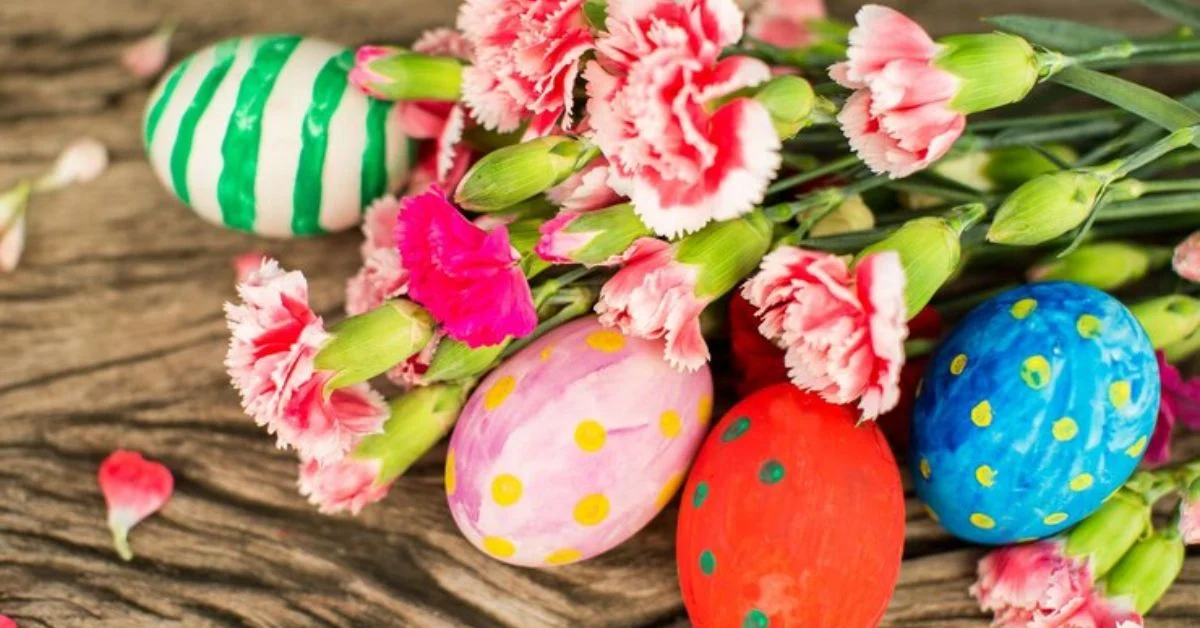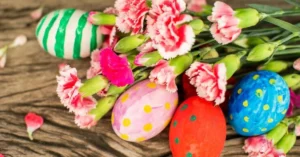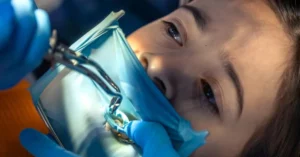Each spring, as winter loosens its grip and daylight begins to linger, homes, churches, and gardens come alive with blooms that signal renewal. These are Easter flowers—floral symbols woven deeply into Christian tradition, seasonal change, and cultural expression. For centuries, they’ve stood not only as decoration but as messengers of hope, rebirth, and the spiritual promise of Easter Sunday.
In the modern world, Easter flowers are more than just a seasonal bouquet. They represent a blend of sacred tradition, horticultural beauty, and cultural continuity. From lilies and tulips to daffodils and hyacinths, each bloom plays a role in this springtime story. Whether gracing altars, adorning dining tables, or blooming in backyard gardens, these flowers carry meanings that transcend aesthetics.
This article explores the origins, symbolism, and contemporary role of Easter flowers—offering an in-depth look at how they’ve come to shape one of the most meaningful holidays on the calendar.
What Are Easter Flowers?
Easter flowers are the blooms most commonly associated with the Easter season, which generally falls between late March and mid-April. These flowers are often chosen not just for their seasonal availability but for their spiritual and symbolic connotations tied to resurrection, purity, and new life.
Commonly recognized Easter flowers include:
- Easter Lily
- Tulip
- Daffodil
- Hyacinth
- Crocus
- Azalea
- Dogwood
- Iris
Each of these flowers carries historical or symbolic weight in Christian iconography, folklore, or the simple observation of seasonal rebirth. In essence, Easter flowers are the visual embodiment of what the holiday represents: renewal, beauty, and the triumph of life over death.
The Easter Lily: Queen of Easter Blooms
The Easter lily (Lilium longiflorum) is perhaps the most iconic of all Easter flowers. With its trumpet-shaped white petals, the Easter lily is rich in both biblical symbolism and liturgical presence.
Symbolism
- Purity and virtue: The white blossom symbolizes the Virgin Mary and is often associated with her chastity and grace.
- Resurrection: In Christian tradition, lilies are believed to have grown in the Garden of Gethsemane, where Jesus prayed before his crucifixion. The flower’s shape evokes trumpets sounding a resurrection.
- Hope: The emergence of lilies in spring, blooming from dormant bulbs, parallels the resurrection story—life rising from apparent death.
In Churches and Homes
Easter lilies are typically used to decorate altars and sanctuaries during Easter services. In homes, they serve as a centerpiece or living décor that aligns with the spiritual tone of the season. Their fragrance and stark beauty make them both a visual and olfactory reminder of the season’s meaning.
Tulips: Love, Grace, and Simplicity
Tulips may not be exclusive to Easter, but their symbolism and seasonal bloom have embedded them in Easter traditions across Europe and North America.
Symbolism
- Love and grace: The simple, symmetrical shape of tulips has long been associated with elegance and emotional warmth.
- Renewal: As some of the first flowers to bloom after snow, tulips signal the definitive end of winter.
Color and Meaning
Each tulip color carries its own message:
- White tulips: Forgiveness and peace
- Yellow tulips: Cheer and friendship
- Red tulips: Passion and deep love
- Purple tulips: Royalty and reverence, often used in church arrangements
In many Easter bouquets, tulips are paired with daffodils or hyacinths to create a bright, varied display.
Daffodils: The Heralds of Spring
Daffodils, also known as narcissus, are among the first signs of spring. Their golden trumpets rising from the earth after months of cold encapsulate the very idea of rebirth.
Symbolism
- Resurrection and new beginnings: Their consistent return each spring made daffodils a natural symbol for Easter.
- Chastity and rebirth: The name “narcissus” links the flower to Greek mythology but also to introspection and spiritual awakening.
In Christian contexts, daffodils are often thought to represent the promise of eternal life, especially because they bloom around the same time as Easter.
Hyacinths and Their Fragrance of Faith
The hyacinth is a fragrant flower that blooms in a dense spike of small blossoms. With colors ranging from deep blue to purple, pink, and white, they are beloved for their aesthetic and spiritual depth.
Symbolism
- Peace of mind and prayer: In the language of flowers, hyacinths are often associated with sincerity and inner peace.
- Suffering and joy: The shape and density of the bloom evoke both the weight of sorrow and the richness of faith.
Many churches use purple hyacinths during Lent, transitioning to white or blue versions during Easter to symbolize the movement from mourning to celebration.
Crocus: The Humble Bloom of Hope
The crocus is one of the smallest and earliest blooming flowers of spring, often pushing up through snow. Its modest presence belies its deep symbolism.
Symbolism
- Joy and cheer: Crocuses are bright and often bloom in clusters, representing communal joy.
- Hope in adversity: Blooming in harsh conditions, they’re seen as a metaphor for enduring faith.
In Christian gardens, crocus bulbs are often planted intentionally to mark the beginning of the Lenten season, visually leading up to the resurrection celebration.
Azaleas, Irises, and Dogwood: Regional Traditions
In the Southern U.S., azaleas in bloom around Easter have become a regional expression of the season’s beauty. Their abundance and pastel palette make them favorites in Easter parades and garden displays.
Irises, particularly the blue or purple variety, are associated with the Virgin Mary and are often used in Marian processions or altars during Easter week.
The dogwood tree, often blooming around Easter, has a strong symbolic presence in folklore. According to one Christian legend, the cross used for Jesus’ crucifixion was made from dogwood, and the tree was later cursed to remain small, bearing blossoms in the shape of a cross.
Easter Flowers Across Cultures
While Christian symbolism is central to Easter flowers, many cultures have adapted and expanded their meanings:
- In Eastern Europe, pussy willows are used instead of palms on Palm Sunday and often accompany Easter baskets.
- In Italy and Spain, Easter week processions often include elaborate floral arrangements carried through the streets.
- In the Philippines, tropical blooms like hibiscus and sampaguita (jasmine) are used to symbolize resurrection and joy.
Globalization has meant that flowers like lilies and tulips have spread across continents, but many cultures still blend them with native flora for localized expressions of Easter.
Growing Easter Flowers at Home
Cultivating your own Easter blooms is a rewarding way to connect with the season. Here are a few tips:
Planting Bulbs
- Plant tulip, daffodil, hyacinth, and crocus bulbs in autumn before the ground freezes.
- Choose well-draining soil and a sunny location.
- Fertilize lightly and mulch to protect from winter weather.
Forcing Blooms Indoors
To time blooms for Easter:
- Chill bulbs for 10–12 weeks in a dark, cool space (refrigerator or unheated garage).
- Transfer to pots indoors 3–4 weeks before Easter.
- Ensure indirect light and moderate watering.
Care Tips
- Remove spent blooms to encourage bulb strength.
- Allow leaves to die back naturally; they feed the bulb for next year.
This hands-on relationship with Easter flowers can turn seasonal decoration into a personal, meditative tradition.
Environmental Considerations
The demand for fresh flowers during Easter puts pressure on global flower markets and carbon emissions. Consider:
- Buying local: Support nearby flower farms for fresher, eco-friendlier options.
- Growing your own: A low-impact and long-term solution.
- Composting: Turn wilted bouquets into soil-enriching compost rather than landfill waste.
Eco-conscious Easter flowers don’t diminish beauty—they deepen it with mindfulness.
The Business of Easter Flowers
Easter is one of the biggest holidays for florists, second only to Valentine’s Day and Mother’s Day. Churches, families, and businesses contribute to a seasonal surge that keeps growers, wholesalers, and retailers in motion.
Trends in the Easter flower market include:
- Sustainable packaging
- Subscription-based seasonal arrangements
- Non-traditional colors and arrangements
- Dried and preserved flowers for longer-lasting displays
For small florists, Easter represents both a logistical challenge and a creative opportunity.
Easter Flowers in Art and Literature
From Renaissance paintings to contemporary greeting cards, Easter flowers appear across cultural media:
- In art, lilies frequently appear in Annunciation scenes, connecting Christ’s conception with His resurrection.
- In poetry, daffodils and tulips symbolize fleeting beauty and eternal renewal.
- In music, Easter hymns often reference blooming gardens and floral symbols of salvation.
These references show how deeply flowers are embedded in the spiritual imagination of spring.
Conclusion
Easter flowers are more than seasonal ornaments—they are living metaphors of a faith, a cycle, and a human longing for rebirth. Whether one views Easter through a Christian lens or simply as a seasonal turning point, the flowers associated with this time offer a rich, multi-layered expression of life returning after darkness.
From the solemn purity of lilies to the joyful blaze of daffodils and tulips, these blooms narrate the Easter story in a language older than words. To cultivate or share Easter flowers is to participate in an ancient tradition of celebration, contemplation, and hope—one as vital today as it was centuries ago.
FAQs
1. Why are lilies associated with Easter?
Lilies, especially white ones, symbolize purity and resurrection, key themes of Easter. They also bloom in spring, aligning with the season.
2. Can I grow Easter flowers at home?
Yes. Plant bulbs like tulips, daffodils, and hyacinths in the fall for spring bloom, or force them indoors for Easter.
3. What do daffodils represent in Easter symbolism?
Daffodils symbolize new beginnings, resurrection, and eternal life, making them a fitting flower for Easter celebrations.
4. Are Easter flowers used in religious services?
Absolutely. Churches use lilies, irises, and hyacinths to decorate altars and sanctuaries during Holy Week and Easter Sunday.
5. Can Easter flowers be eco-friendly?
Yes. Choose locally grown blooms, avoid plastic wrapping, and compost spent flowers to minimize environmental impact.
For more information, click here.









